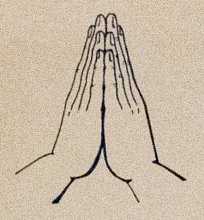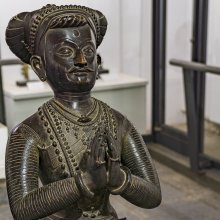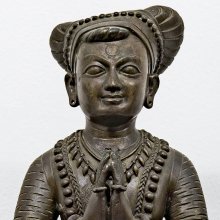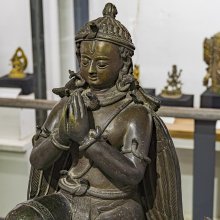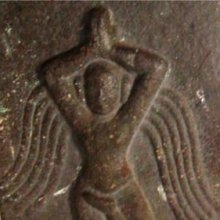Anjalimudra, Añjalimudrā, Anjali-mudra: 1 definition
Introduction:
Anjalimudra means something in Hinduism, Sanskrit. If you want to know the exact meaning, history, etymology or English translation of this term then check out the descriptions on this page. Add your comment or reference to a book if you want to contribute to this summary article.
Images (photo gallery)
(+44 more images available)
In Hinduism
Shilpashastra (iconography)
Source: Shodhganga: Vaisnava Agamas And Visnu ImagesAñjalimudrā (अञ्जलिमुद्रा) or simply Añjali refers to one of the various hand-poses (hastas or mudrās) defined in treatises such as the Pāñcarātra, Pādmasaṃhitā and Vaikhānasa-āgamas, extensively dealing with the technical features of temple art, iconography and architecture in Vaishnavism.—Añjalimudrā signifies salutation and adoration. In this saṃyuta hand-pose the open hands are placed side-by-side and slightly hollowed with the hands are clasped together with the palms touching together. Añjalimudrā held close to the chest is called hṛdaya-añjali.

Shilpashastra (शिल्पशास्त्र, śilpaśāstra) represents the ancient Indian science (shastra) of creative arts (shilpa) such as sculpture, iconography and painting. Closely related to Vastushastra (architecture), they often share the same literature.
See also (Relevant definitions)
Partial matches: Mudra, Anjali.
Full-text (+19): Anjali, Anjali Mudra, Anuradha, Pushya, Ashlesha, Purvaphalguni, Purvabhadrapada, Rohini, Vishakha, Ardra, Krittika, Punarvasu, Bharani, Uttaraphalguni, Mula, Svati, Shatabhisha, Dhanishtha, Purvashadha, Uttarabhadrapada.
Relevant text
Search found 6 books and stories containing Anjalimudra, Añjalimudrā, Anjali-mudra, Añjali-mudrā; (plurals include: Anjalimudras, Añjalimudrās, mudras, mudrās). You can also click to the full overview containing English textual excerpts. Below are direct links for the most relevant articles:
The Indian Buddhist Iconography (by Benoytosh Bhattachacharyya)
108 forms of Avalokiteśvara (36): Jñānadhātu Lokeśvara
Figure 239 - Ten principal Hindu deities: Brahmā
108 forms of Avalokiteśvara (4): Harihariharivāhana Lokeśvara
Jain Remains of Ancient Bengal (by Shubha Majumder)
Jain Tutelary Couple or Parents of the Tīrthaṅkaras < [Chapter 6 - Iconographic Study of Jaina Sculptural Remains]
Pañca-tīrthika type of Mahāvīra sculptures < [Chapter 6 - Iconographic Study of Jaina Sculptural Remains]
Jain Aṣṭāpadatīrtha Sculptures < [Chapter 6 - Iconographic Study of Jaina Sculptural Remains]
Amaravati Art in the Context of Andhra Archaeology (by Sreyashi Ray chowdhuri)
The Great miracle at Śrāvastī < [Chapter 3 - Amarāvatī and the Formative Stage of the Buddhist Art]
Jainism in Odisha (Orissa) (by Ashis Ranjan Sahoo)
Jaina Vestiges at Jagulei Shrine, Kartara < [Chapter 3: Survey of Jaina Antiquities in Odisha]
Parsvanatha image at Dahikhai Thakurani, Tentulidiha < [Chapter 3: Survey of Jaina Antiquities in Odisha]
Santinatha at Ganesa Temple, Dasasvamedha Ghata < [Chapter 3: Survey of Jaina Antiquities in Odisha]
The gods of northern Buddhism (by Alice Getty)
Stupas in Orissa (Study) (by Meenakshi Chauley)
Buddha Images < [Chapter 5]
Minor Structural Stupas at Udayagiri (Southern Zone) < [Chapter 4]
Minor Votive Stupas at Udayagiri < [Chapter 4]
